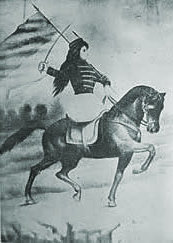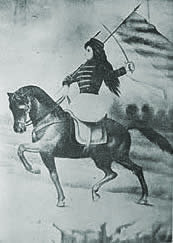
|
Women and Independence in Latin America An exploration of women's involvement in the Latin American Wars of Independence |

|

|
Women and Independence in Latin America An exploration of women's involvement in the Latin American Wars of Independence |

|
Click on one of the images below to see the full-size image
 Domingo Sarmiento |
 Juana Josefa Sarmiento |
Gender:Male
Ethnic origen: White
Events:
| 1811 | - | San Juan | - | Not applicable | - | He was born 15 February 1811. |
| 1831-1836 | - | Chile | - | Unknown | - | He was in exile in Chile from 1831-36. |
| 1837 | - | Buenos Aires | - | Unknown | - | He co-founded and was a member of the Salón del '37 here. |
| 1839 | - | San Juan | - | Unknown | - | He established a school for girls in San Juán. |
| 1840 | - | Santiago de Chile | - | Unknown | - | He went into exile here during Rosas's rule. Contributed to various newspapers. |
| 1840 | - | United States of America | - | Unknown | - | He travelled here inspecting schools in the 1840s. |
| 1840 | - | Chile | - | Unknown | - | He fled to Chile from Argentina. |
| 1845 | - | United States of America | - | Unknown | - | He travelled to the United States, Europe and North Africa inspecting schools. |
| 1848 | - | Chile | - | Unknown | - | He married Benita Martínez Pastoriza in Chile on 19 May 1848. |
| 1848 | - | Yungay | - | Unknown | - | He lived here with his second wife from around 1848. |
| 1862 | - | Chile | - | Unknown | - | His marriage to Benita Martínez Pastoriza broke down. |
| 1888 | - | Asunción | - | Unknown | - | He died in Asunción, Paraguay, on 11 September 1888. |
Connections:
Anti-indigenous/ anti-blackBiography:
Born in 1811, he was a member of the “Generación del ’37”. He had a bitter split with Alberdi after Rosas fell in 1852. (Shumway.) His belief in White European superiority was part of his opposition to Rosas whose supporters were mestizos, pardos and blacks from the middle and lower classes. “Explicit racial overtones” can be perceived in his biography of Angel “El Chacho Peñaloza”. This was also the case inCivilization and Barbarism. Katra points out that such attitudes were typical of his class at that time. (Katra, 31.)
He held a polemic with Andres Bello in the Chilean newspapers El Mercurio and La Revista de Valparaíso in the 1840s defending Romanticism and a renovated Hispanic American language. (Katra, 69.)
Sarmiento visited Mariquita Sánchez in 1845, with a letter of introduction from Esteban Echeverría (Sáenz Quesada, 207. )
In 1837, Sastre, Alberdi and Juan María Gutierrez founded the Salón del ’37, a Buenos Aires based salón literario. This was also known as Marcos Sastre’s Salón Literario. It was composed of a group of young intellectuals who were dissatisfied with Rosas’s infiltration/ control of the University. They met in Sastre's library to design a project of national conscience and liberal reforms to bring about Rosas’s downfall. It had about 50 members, among them Vicente López, and Esteban Echeverría. They also devised the cultural programme implemented by Sarmiento. (Denegri, 120.) It lasted only for a few months due to Sastre’s approval of Rosas for having brought order and peace to Argentina. (Katra, 48.)
He believed that women instinctively knew how to educate and care for their children, and that women should be taught greatness and virtue in order to create great and virtuous men. He maintained women had will, reason, and passions and were equally as capable as men of studying. (Knaster, 129.)
He had a long-standing relationship with Dalmacio Vélez Sársfield (one daughter, Aurelia). He was married to Benita Martínez Pastoriza (one daughter, Faustina). (Knaster, 20)
He was in exile in Chile in 1831-36. After his return to San Juan, in 1836, he opened the Colegio de Santa Rosa de América, a school for young ladies in 1839. He travelled to the United States, Europe and North Africa, inspecting schools from 1845-48. (McQuade, 755-756)
He married Benita Martínez Pastoriza in Chile on 19 May 1848. They and Sarmiento's daughter from his first marriage, Faustina, lived in Yungay in a property she had inherited. The marriage broke down in 1862 after Sarmiento's affair with Aurelia Vélez. Sarmiento disinherited her on the grounds that she did not need his money, but she managed to obtain half of his wealth. (Sosa de Newton, 393-394)
The structure of Civilización y barbarie shows influence of Tocqueville, Herder, and Montesquieu. Franco explains that Sarmiento chose to depict Quiroga because he knew him, and drew on his own memories and the anecdotes of others when writing about him. It is Romantic, but like Echeverría's La cautiva, nature is barbaric, whereas the city is civilized. (Franco, 42-46)
He died in 1888.
References:
Smith, Verity (editor). (1997) Encyclopedia of Latin American Literature
Coester, Alfred (1919) The Literary History of Spanish America
Denegri, Francesca (1996) El Abanico y la Cigarerra: La primera generación de mujeres ilustradas en el Perú, 1860-1895
Franco, Jean R.O. Jones (editor). (1973) Spanish American Literature Since Independence
Katre, William H. (1996) The Argentine Generation of 37, Echeverría, Alberdi, Sarmiento, Mitre
Knaster, Meri (1977) Women in Spanish America: An Annotated Bibliography from Pre-Conquest to Contemporary Times
Sáenz Quesada, María (1996) Mariquita Sánchez, Vida política y sentimental
Shumway, Nicolas (1991) The Invention of Argentina
Sosa de Newton, Lily (1986) Diccionario biográfico de mujeres argentinas